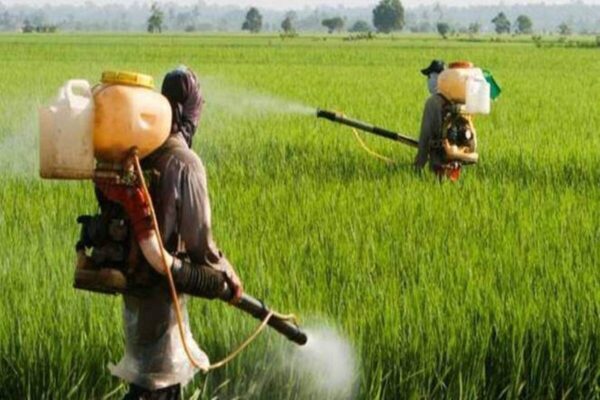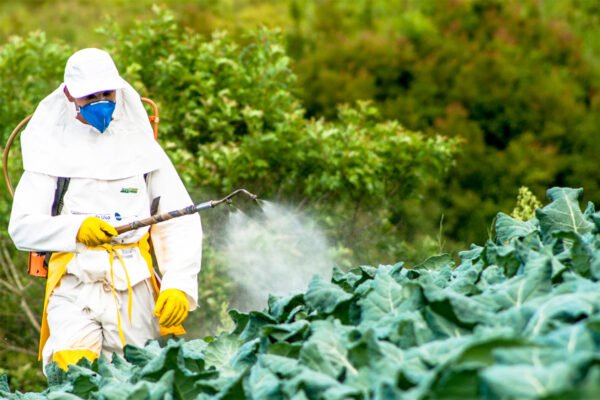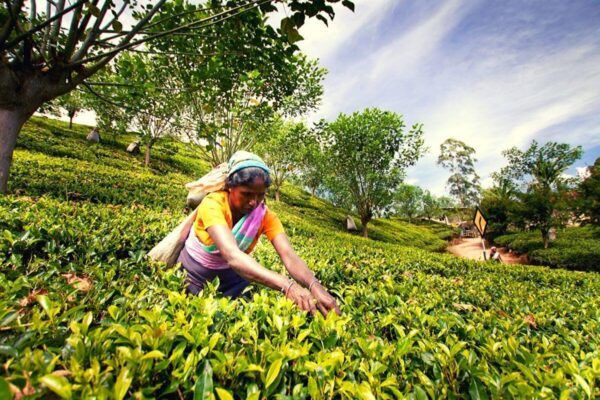India’s Agrichemical Industry- A potential game-changer? Look at these key opportunities for the industry

India’s Agrichemical Industry- A potential game-changer? Look at these key opportunities for the industry.
With 2.4 percent of world land resources and 4 percent of global water resources, India sustains over 1.3 billion people today. Agriculture is a major contributor to national GDP, with food grain output expected to reach 316 million tonnes in 2021, accounting for roughly 18% of national GDP during this period. Increased production of pulses, coarse grains, natural fibres, sugarcane, vegetables, and fruits has driven this expansion.
Agriculture continues to play an important role in driving India’s GDP growth. The agrochemicals business, with a market size of roughly Rs 30000 Cr, would play a crucial part in enhancing India’s agricultural capability. Food grain consumption is increasing faster than production due to the ever-increasing population and limited arable land. However, pests, weeds, and illnesses cause 15-25 percent of potential agricultural yield to be lost.
The need and requirement for increased crop productivity, with an emphasis on effective pest control techniques and weed management practices, have been considered to be essential for increasing agricultural output, obtaining raw materials for production, and distributing agrichemicals to consumption sites are crucial game-changers in attaining these objectives.
According to estimates from the Federation of Indian Chambers of Commerce and Industry, India’s agrochemical industry is predicted to grow 8-10 percent by 2025. (FICCI). Because of the low level of agrochemical consumption, the industry has enormous untapped potential. Per capita consumption in India is 0.6 kg/hectare, compared to 13.1 kg/hectare in China.
After the coronavirus pandemic slowed growth in the country’s metropolitan pockets, where most of the factories and offices are located, most firms are depending on a bumper harvest and high rural wages to drive demand for goods.
A regular monsoon, record sowing of summer crops, increased winter harvest, and a slew of government initiatives are expected to raise rural incomes and drive demand for commodities ranging from two-wheelers to tractors.
Consumer durables manufacturers, farm input producers, cement enterprises, and critical products manufacturers are among those who stand to benefit. Tractor Sales, a leading indicator of rural demand, have surged across rural areas and are on track for record increases.
Agrochemical Industry 2022
The agrochemical business is expected to grow significantly by the end of 2022 as a result of the sector’s diverse implementation approaches toward safety and the issues encountered in maintaining effective management of food safety operations.
Since the beginning of the year, there has been an increase in chances to expedite reforms in the food and agrochemical sectors to improve resilience in the face of several problems, including climate change. While the epidemic caused significant challenges for every other economic sector, it has largely unaffected the agrochemical industry in the long run.
In 2021, the agrochemical sector saw significant improvements and product developments. Even in difficult circumstances, the introduction of faster and more cost-effective analytical technologies has provided the sector with a significant boost.

Despite rising input prices, income has climbed dramatically due to higher output volumes and greater output prices.
With new technology changing the face of food production, from how it is grown, produced, packaged, and sold, it presents both opportunities and challenges, such as the adoption of a broader risk management plan for mitigating various challenges, such as the ongoing pandemic and the resulting labour shortage, evolving work environments, inflation, commodity prices, and supply chain concerns. These are anticipated to alter the agrochemical landscape in the coming year.
Furthermore, over the projected period, the increasing application and usage of enantiomerically pure components in the agrochemical industry are expected to accelerate.
Furthermore, market sales are expected to climb in line with the rising demand for environmentally friendly pesticides, which has led to increased use of chiral compounds in herbicides, plant growth regulators, and fungicides.
SK Chaudhary, Founder and Director, Safex Chemicals, predicted the agrochemical forecast 2022, saying, “Just as technology has altered many aspects of the economy, it will continue to have an impact in the realm of agriculture and farming.” Despite recent pandemics, the agrochemical sector has been unscathed since its inception. We have been ensuring regulatory steps to protect the environment because the industry contributes significantly to food security and employs a huge workforce.
With all of the innovations and developments on the way, By the end of 2022, an excellent potential in the industry is expected..”
“The agrochemical sector is currently developing as a champion that has the potential to become a vital worldwide supply hub,” he added. Although IT technologies have aided in the evolution of the agrochemical sector’s workflow, we are focusing our efforts on talent augmentation and continual workforce training to achieve greater results in the coming year.”
As a result of the diversity of implementation strategies in the sector toward safety and the issues experienced in maintaining efficient management of food safety processes, the agrochemical industry is expected to see a significant jump in 2022.
Competitive Landscape
Bayer CropScience, Syngenta AG, UPL Limited, BASF SE, National Fertilizer Limited, and TATA Rallies are among the prominent competitors in the agrochemicals market. These market leaders’ primary strategies include new product launches, mergers & acquisitions, and alliances. To grow their market share, these companies are focusing on investing in innovations, collaborations, and expansions.
Key Players
The following are the top players in the India Agrochemicals Market.

- Bayer Crop Science
- AG Syngenta
- Limited UPL
- SE BASF
- National Fertilizers Limited
Recent Developments
Crystal Crop Protection Limited will launch HOLA, a post-emergent herbicide, in February 2022 to protect sugarcane crops across the country from weeds.
FMC Corporation entered into a long-term strategic partnership with UPL Limited in March 2021 to supply Rynaxypr active (insecticide) for use in its product formulations.
Consumption of Agrichemicals
Because of the government’s agriculture-focused attempts to improve production and reduce crop loss, India has emerged as one of the world‘s major producers of agrochemicals. This agrochemicals market is expected to be worth USD 7.2 billion in 2021, with a total pesticide consumption of 62,000 metric tonnes. This consumption is largely influenced by weather and rainfall patterns. Higher temperatures and moisture increase the likelihood of pest infestation, pushing up pesticide consumption.
The need for insecticides and fungicides dominates the country’s agrichemical business, accounting for 75 percent of total consumption. As the Central Government focuses on promoting sustainable agricultural practices, the usage of bio pesticides is increasing, accounting for 15% of the market.
With about half of its demand coming from beyond its boundaries, India is also one of the top 10 agricultural exporters. Agrochemical exports are expected to reach $3.8 billion in 2021, having increased at a CAGR of 16% between 2016 and 2021. Unlike local demand growth, which varies according to rainfall patterns, exports of agrochemicals have increased consistently. Brazil, the United States of America, Japan, Vietnam, France, and China are among the top agrochemical export destinations.
Supply Chain Challenges
The COVID epidemic has revealed flaws in the agrichemical supply chain, causing temporary interruptions in manufacturing and exports. In the past, India relied largely on imports of raw materials and intermediates to make agrochemicals.
The paucity of these materials during the pandemic, as well as port congestion, caused procurement delays, affecting manufacturing and export schedules. As a result, manufacturers and suppliers are rethinking their manufacturing and distribution strategies to address potential issues.
The state government agencies, commercial dealers, and cooperative organizations are important players in the distribution of agricultural chemicals. Around 90% of distribution outlets are centred in three key agricultural producing regions: the North, West, and South. Distribution of agricultural chemicals is one of the industry’s most difficult challenges due to the extensive nature of land holding patterns in remote places.
Given the agrichemical sector’s growth potential, the Indian government has recognized it as one of the 12 industries with the potential to achieve global leadership. Firms and relevant industry bodies must undertake efforts and steps to revive and overcome obstacles associated with the sector’s logistics.
Furthermore, substandard, counterfeit pesticides, accounting for roughly 25% of total agrichemicals, infiltrate through the distribution network, compromising the quality of arable land, health, and the environment.
Roadmap to Success
Aligning with Backward Integration Strategies:
To reduce reliance on external raw material procurement, many organizations are looking at localizing raw material supply by establishing or acquiring units to manufacture raw materials and intermediates.
To enable seamless manufacture of agrichemical goods, supply chain and logistical requirements must be re-aligned with advances and changes in the sector’s whole value chain.
Strengthening the Distribution Network:
The crop protection market requires a strong and effective distribution network due to the high number of end customers from a wide geographic region and the rising usage of generic (off-patented) agrochemicals. Additionally, it implies a mechanism that will prevent fake and illegal goods from reaching the general market.
Domestically, a lack of a distribution network makes it difficult for agrochemical companies to reach out to isolated rural areas to provide the latest products and advances and raise knowledge of their benefits to crop management and agriculture.
Digitization of the Supply Chain:
Agrichemical consumption varies according to weather conditions and rainfall patterns. Rainfall is responsible for over 30% of arable land in India, it should be considered while projecting demand for insecticides, fungicides, weedicides, and rodenticides to minimize pesticide surplus at distribution points.
Adoption of digital solutions for increased visibility and tracking will substantially improve monitoring of agrochemical product movement across the supply chain network.
Government and Industry Collaboration:

With the prominent role played by the state agencies in agrochemical procurement and distribution, a collaborative approach by industry, government, and regulatory bodies is needed to remove bottlenecks associated with transportation, storage, and distribution. This will improve the smooth movement of agrochemicals, increasing both domestic and international consumer bases.
Opportunities for the Indian Agrochemical Industry
Export Potential:
Internationally, Indian agrochemical companies are known for their high quality and cost-effectiveness in making molecules of organophosphorus, carbon disulfide, and pyrethroid chemistries through complete backward integration. These things have gained international recognition and are exported in large quantities from India.
India’s present export turnover is USD 3.00 billion, and potential to increase it further by producing products in other chemistries. Furthermore, we can enter the global market by producing combination medications that are acceptable globally due to their broad-spectrum efficacy.
Investing in Research and Innovation:
In keeping with the Make in India and Atma Nirbhar Bharat programs, the Government of India is focusing on research and development with innovation. Government and industry have begun to invest heavily in research and development to develop new generation molecules, new isomers, new manufacturing processes, green chemistry products, and new combinations and solo formulations to make India a global hub for agrochemical product manufacturing.
They can also collaborate under the Public-Private Partnership model, for which the government is contributing cash to improve the country’s R&D environment. Additionally, these projects would contribute to maximizing India’s and the world’s abundant scientific and technological human resources.
Development of Efficient & Environmentally Safe Products:
Farmers in India are looking for efficacious and environmentally safe products that are effective for pest management at extremely low levels of a few grams per acre. There is a high need for the development of many such products, which would benefit all stakeholders and will also aid in the promotion of the country’s agricultural exports.
Intellectual Property System:
The intellectual property regime encourages the industry to innovate on technologies and goods by offering 20-year patent protection. Many companies have been able to invest in R&D efforts to develop novel technologies and products and acquire protection both in India and abroad through PCT or Paris Convention pathways.
Petroleum, Chemicals, and Petrochemicals Investment Regions (PCPIR):
Multiple regions in different Indian states have been identified as PCPIR with all of the necessary facilities and government support to improve the production of various chemicals, including agrochemicals, petroleum, and petrochemical goods.
Industry can use these facilities to construct and commission units for the production of technical grade products with complete backward integration to lessen reliance on imports for such items.
The CRAMS and CSM Models Will Help India Become a Global Manufacturing Hub:
The global Contract Research and Manufacturing Services (CRAMS) market is valued at USD 200 billion in 2019, with India accounting for 6%, or USD 11.5 billion.
The CRAMS market in India is predicted to grow at a 12 percent CAGR in 2022 and 24 compared to a global CAGR of 10 percent. In India, the CRAMS market is 35 percent dominated by agrochemicals.

Custom Synthesis and Manufacturing (CSM) is a subset of the CRAMS paradigm that deals with proprietary items that necessitate additional R&D activities.
As more innovators focus on their core strengths and outsource production through long-term contracts to low-cost manufacturing locations such as India, Indian CRAMS/CSM players would gain. In comparison to other specialist players, these long-term contracts provide long-term revenue growth visibility.
CSM necessitates more R&D efforts than CRAMS because contract manufacturers produce patented products, and each patented product’s manufacturing can be unique, necessitating distinct infrastructure. CSM is a more specialized area of the contract manufacturing space, with larger margins than CRAMS for generic compounds.
With the expansion of contract synthesis infrastructure in India, more foreign firms with patented products are likely to create active compounds. As a result, the valuation for CSM or patentable enterprises is substantially greater, and manufacturing services in the contract synthesis sector have stronger growth potential.
The India CSM market for speciality chemicals was valued at USD 11.5 billion in 2019 and is predicted to reach USD 20.3 billion by 2024, with a 12 percent CAGR driven by:
a) the growing contract manufacturing trend in India for fine chemicals and niche speciality chemicals;
b) multinational corporations opting to engage in contract manufacturing in India; and
c) India’s status as a low-cost manufacturing hub with a skilled labour population.
Fine chemicals, which are single-molecule compounds commonly employed in crop protection chemicals and Active Pharmaceutical Ingredient industries, account for about 80% of the Indian specialized CRAMS industry. The majority of these single-molecule substances are used as active ingredients in agrochemical and pharmaceutical formulations.
Agrochemical contract manufacturing in India accounts for 35% of the market, with demand driven primarily by exports.
Regulatory Framework:
The Government of India is opening up the regulatory framework for agrochemicals in the country, having developed the policy, rules, and regulations for pesticide applications using drones.
The government has also begun to focus on expediting the registration of novel crop protection molecules in the country and is working on the methods for this.
Policy Interventions for Foreign Investments:
The Government of India’s different industry-focused policies has allowed international companies to start investing in India by either establishing their own companies in India or cooperating with Indian corporations to build joint venture enterprises. This offers a new avenue for introducing new technologies and products to India for the benefit of Indian agriculture and farmers.
Technology Interventions:
Both the government and industry are working on bringing tools to a digital platform to disseminate information among farmers for weather conditions, rainfall, and so on to help them plan properly for the next farming season, and proper information on the proper use of agricultural inputs, training, and so on so that the country’s food productivity can be maintained.

Way Forward For AgriChemical Industry
The opportunities available to the industry and policymakers can help them decide and work in the direction of bringing newer technologies, novel molecules, efficacious combinations, enhancing manufacturing, and solo formulations infrastructure, and creating a proper policy environment to help in improving productivity and foreign investment in the country to increase the share of agrochemicals in the country’s GDP and exports by utilizing the vast untapped potential at a domestic and global level.
For India to become a worldwide manufacturing centre for agrochemicals, the industry must prioritize R&D investments, partnerships with R&D labs and research institutes, and capacity expansion. The PLI program is designed in such a way that there is a production threshold above which the incentives kick in, so indirectly encouraging PLI enterprises to export excess production (beyond the domestic demand).
The PLI plan has proven to be effective in the pharmaceutical and mobile manufacturing industries, and it is projected to provide appropriate incentives to Indian companies, assisting India in becoming one of the main production centres for the global agrochemical industry.
Policymakers must prioritize stimulating the production of final goods and the convenience of doing business. They need to tone down regulatory methods in order to make them more stable by limiting shocks and surprises and investing in on-the-ground inspection and implementation capabilities.
Focusing on R&D and producing new goods would be a big contribution to India’s intellectual property, which will benefit enterprises in the long term. The current environment is advantageous and suitable for the Indian agrochemical industry to grow and establish itself as a major global manufacturing hub. It will be fascinating to watch how the industry uses the benefits and adapts because this will decide its future.
Government collaboration is very crucial in the Agrichemical industry as it will stimulate the economic growth of the country and expand our base in the agriculture sector and visibility globally.
Edited by Prakriti Arora




